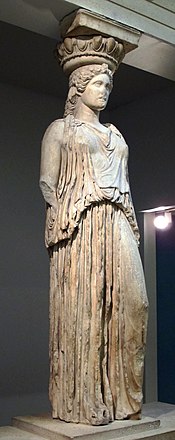
Back تماثيل عذارى كارواي Arabic Kariatid Azerbaijani Карыятыда Byelorussian Кариатида Bulgarian Cariàtide Catalan Karyatida Czech Karyatide Danish Karyatide German Καρυάτιδες Greek Kariatido Esperanto


A caryatid (/ˌkɛəriˈætɪd/ or /ˌkæriˈætɪd/ KAIR-ee-AT-id or KARR-ee-AT-id;[1] Ancient Greek: Καρυᾶτις, pl. Καρυάτιδες)[2] is a sculpted female figure serving as an architectural support taking the place of a column or a pillar supporting an entablature on her head. The Greek term karyatides literally means "maidens of Karyai", an ancient town on the Peloponnese. Karyai had a temple dedicated to the goddess Artemis in her aspect of Artemis Karyatis: "As Karyatis she rejoiced in the dances of the nut-tree village of Karyai, those Karyatides, who in their ecstatic round-dance carried on their heads baskets of live reeds, as if they were dancing plants".[3]
An atlas or atlantid or telamon is a male version of a caryatid, i.e., a sculpted male statue serving as an architectural support.
- ^ "Definition of CARYATID".
- ^ Καρυᾶτις in Bailly, Anatole (1935) Le Grand Bailly: Dictionnaire grec-français, Paris: Hachette
- ^ (Kerenyi 1980 p 149)
© MMXXIII Rich X Search. We shall prevail. All rights reserved. Rich X Search